Ski Fitness Workout and Training
| Here are some tips and guidelines for fitness preparation and training for the ski season. |
For many of us, the ski season usually begins during late November through early December. But, will your body be ready for the demands that it must endure for you to safely get down the mountain?
Safe skiing is the best skiing. Statistically ski injuries occur in the afternoon (time of day is a 0.45/1.00 risk factor - ref). Age is an even higher risk factor (0.98/1.00 - ref), showing the vulnerability of a weaker body. Many of these injuries happen as a result of pushing the body further than it is safely capable of going. Fatigue, inflexibility, lack of strength and balance, combined with high altitude and cold weather can lead to accidents and injury.
Prior and leading up to the ski season one should take time to include a regular "preseason" workouts to harness the ability to successfully get your body into proper physical condition for the type of skiing you plan to do. Pre-ski season exercising should begin 12 weeks to a minimum of 8 weeks prior to skiing. Exercising should not be overlooked and will benefit both recreational and competitive skiers. When preparing physically for the ski season, it is important to focus on "ski-specific" exercising.
If you are not sure of your body's physical condition, it would be in your best interest to consult with your physician before attempting any exercises.
When exercising always remember to breathe deeply.
- Stretching / Inner thighs - Leg Extensions
- Begin standing with your back straight and your feet spread wider than your shoulders, while keeping both feet firmly established on the ground.
- Lean gently to the left, keeping your right leg extended and slightly bending your left knee.
- Place both hands on your left knee then drop your right knee towards the ground without touching the ground.
- Hold this position for 10 to 15 seconds.
- Now repeat the same method in the opposite direction.
- Repeat this stretch in both directions 2 to 3 times.
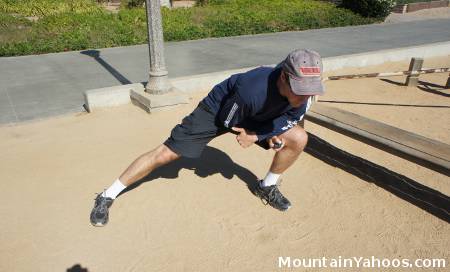
- Stretching / Thighs - Quadriceps
- While standing place left knee on a chair, stepping forward of the left knee with the right foot.
- With your right hand grab your left ankle and lean forward. Hold for 30 to 45 seconds.
- Repeat for the other leg.
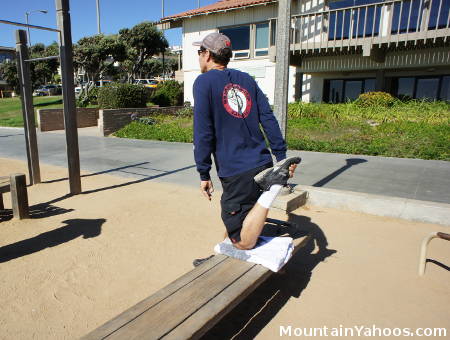
- Stretching - Trunk Rotation
- Sit on the floor with both your legs straight out in front of you. Toes facing up.
- With your left leg straight, bend your right leg with your right foot crossed over your left leg.
- Place you're your left elbow across the outside of your right knee and lock your elbow into place.
- Rotate your trunk (upper body) to the right and hold for 30 to 45 seconds.
- Repeat for the other side.
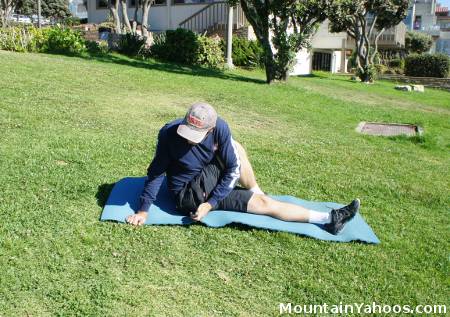
- Stretching - Calves
- Stand straight with the balls of both feet on the floor. Lift and lower both heels of your feet together for 2 to 3 sets of 10 to 15 reps.
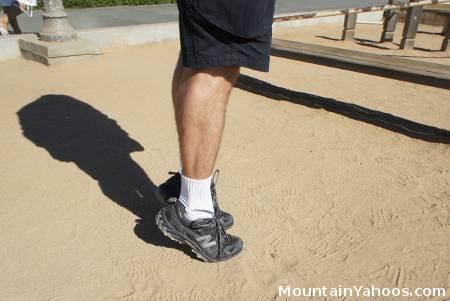
or place the left leg on a raised object, lean forward and articulate the right leg forward while keeping the foot firmly planted on the ground.
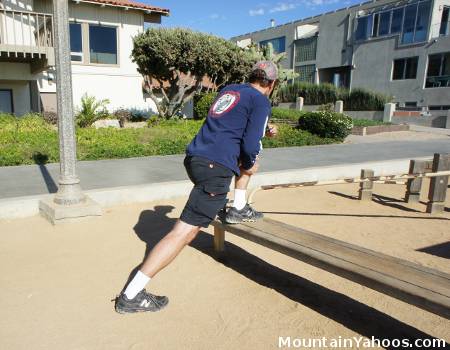
If the calf stretches are performed before going to bed after a hard core day on the bumps, it will help you maintain the ability to walk the next day.
Lack of endurance is a result of one or a combination of many factors such as low daily cardiovascular activity, lack of sleep, improper diet, substance abuse and smoking.
Preseason training for endurance should include reducing or eliminating controlled substances, alcohol and cigarette intake. It should also include eating a balanced diet on a regular basis as well as a consistent and adequate sleeping regiment.
Possible routines to consider three to four times per week are as follows
- 20-45 minutes on a treadmill
- 20-45 minutes of fast walking
- 45-60 minutes of tennis
- 25-45 minutes of bicycling
- 30-45 minutes of swimming laps
- 25-45 aerobic dancing
- 30-45 minutes jogging
- 45-60 minutes of hiking
- 20-25 minutes of jump roping
- 20-45 minutes traversing sand dunes
- 20-45 climbing stairs
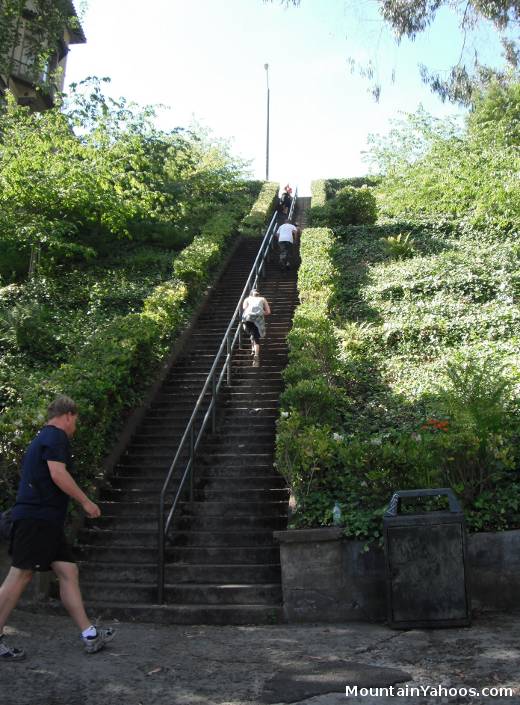
San Francisco CA: Stairs at the end of Lyon Street (corner of Lyon and Green)
Mill Valley CA: DIPSEA Stairs (trail from the valley/dip to the Pacific/sea)
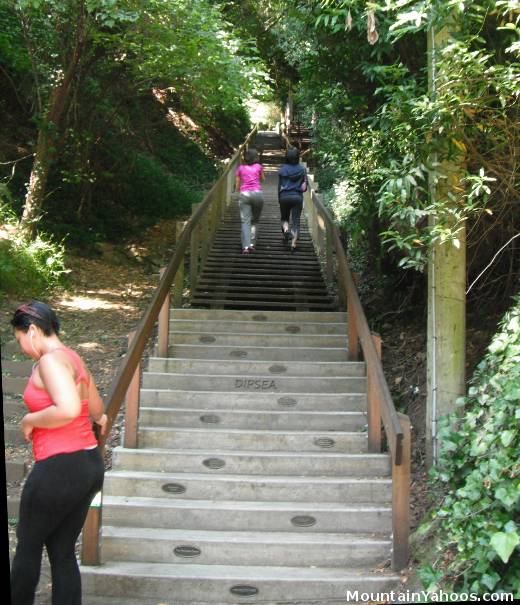
Part I: Entrance at the corner of Cascade and Molino
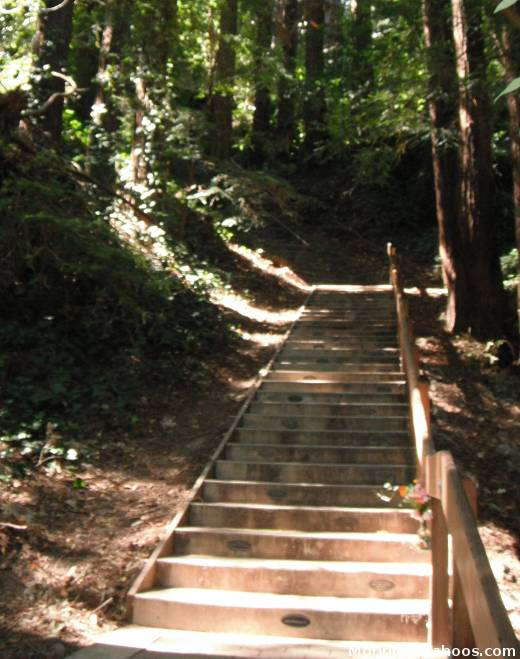
Part II
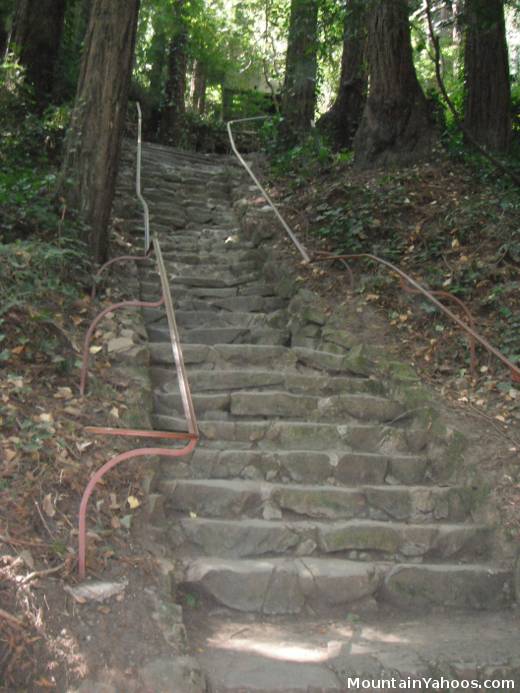
Part III and it keeps going to part IV, V, ...
Skiing requires strength from many muscle groups of the body such as the legs, including the front thighs (quads), back thighs (hamstrings), inner and outer hips, buttocks, knees, ankles, feet, and abdominal, as well as the back and arms.
Strength is vital to downhill skiing, as it is an activity which entails all the major muscle groups working together. Keep these facts in mind when working out. The back works with the abdominal, the feet work with the ankles, the knees work with the thighs, and so forth.
Lower and upper weight training is beneficial for superior results and essential for a strong skier. The most common ski injuries are related to the joints and the best way to protect the joints is by building muscle around the joints. However, it is important to remember that muscles can stretch and tear so, therefore, muscle building is of strong importance.
For a gym workout, consult with the staff and let them know that your interested in "ski-specific" exercising. Remember to start with lower weights and build up.
Suggested Weight Training Exercises For The Lower Body:
- Leg Extension Machine for the Quads
- Hamstring Curl Machine
- Leg Press - Quadriceps
- Calf Machine
Essential Strength Building Exercises:
- Breathing (Strengthen diaphragm to improve breathing)
- Squats
- Sit-ups
- Leg lifts
- Strength Building Exercises - Wall Sits / Quads
- Bend knees to 90 degrees placing back flat against the wall.
Hold in this position for 30 to 45 seconds. - Repeat 3 to 4 times following 30 seconds rest between each set.
- When bending your knees, remember to keep your thighs horizontal and your lower leg vertical.
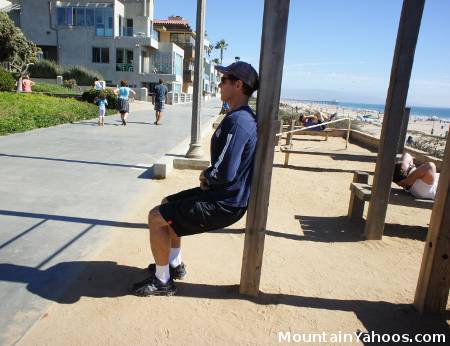
- Bend knees to 90 degrees placing back flat against the wall.
- Strength Building Exercises - Legs / Double Leg Jump
- Roll up a beach towel and place it on the floor.
- Standing with both feet together to the right of the rolled up beach towel, jump sideways to the left of the towel and return in the opposite manner. Continue for 45 to 60 seconds.
- When jumping both feet should leave the ground simultaneously. When landing, emphasize a smooth landing. In landing, take the stress off of the knee joints by bending the knees and focusing on using the thigh muscles.
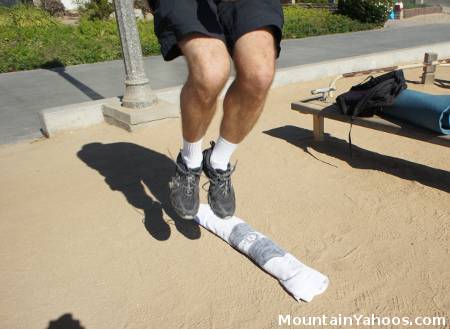
or jump over a higher object to build more strength
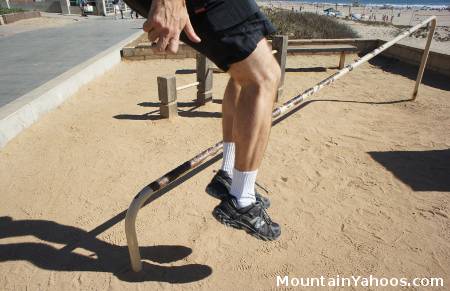
- Strength Building Exercises - Lower Body / Trunk
- Begin by laying on your lower back and buttocks with your left leg bent and right leg straight between 10" to 12" inches off of the floor at the foot. Place the palms of each hand behind the head on each side (behind each ear and bent at the elbows).
- Reach for the left knee with the right elbow while exhaling at the same time. Keep your hands loose, disallowing you to pull your neck and head forward.
- Repeat in the opposite direction without contacting the floor with your upper back.
- Strength Building Exercises - Hamstring
- Begin by placing both knees on the floor on top of the comfort of a soft rolled up towel or cushion.
- Firmly lock your heels under an immovable object such as a mattress or bed frame.
- Lean forward for 5 to 10 seconds and return. Repeat 8 to 10 times.
- Take caution when leaning forward not to put too much strain on your hamstrings.
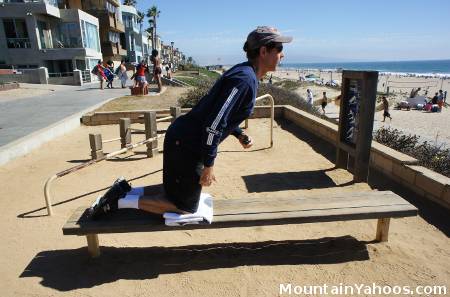
- Strength Building Exercises - Legs
- Walking or running up steep hills.
- Mountain and trail hiking with weights on your back.
- Where available, climbing up and coming down sand dunes.
- Climbing stairs or using a stair stepping machine
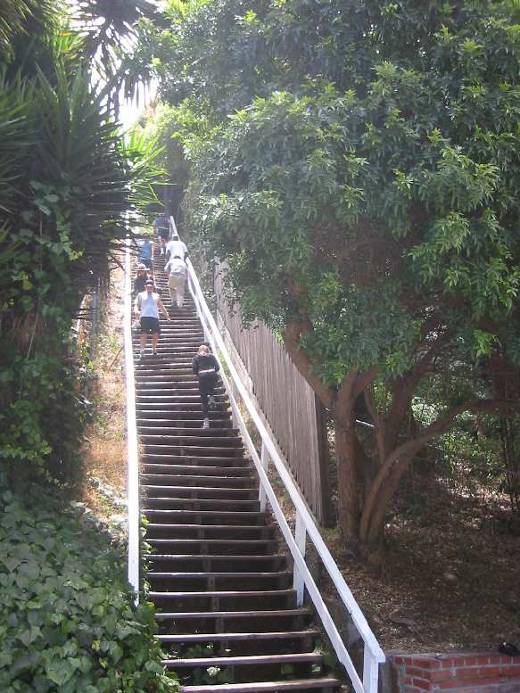
Santa Monica CA Stairs (at the end of fourth street)
Balance and stability are crucial for all levels of skiing. Without balance, you will pay a price with sore over-worked muscles and aching joints. By targeting your abdominal, lower back, legs and hips, you will not only gain stability, but will build strength and endurance at the same time.
Jumping rope is a great way to gain balance. Also, strength jumping from one leg to another as well as with both legs at the same time will maximize the benefit of your jump roping routine as a means to achieve balance.
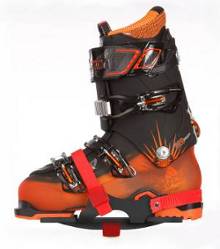
| SkiA.com "Sweetspot" training balance blocks: graduated system of training with a decreasing block size under your foot to increase difficulty and balance effort. |
US:
- 24 Fitness
- Bally Total Fitness
- Curves - ladies only
- Golds
- Spectrum
- YMCA
- World Gym
- Indoor simulated skiing and snowboarding
- Ski and snowboard training camps - racing, freestyle, ...
- SkiersEdge.com - ski fitness training machine



